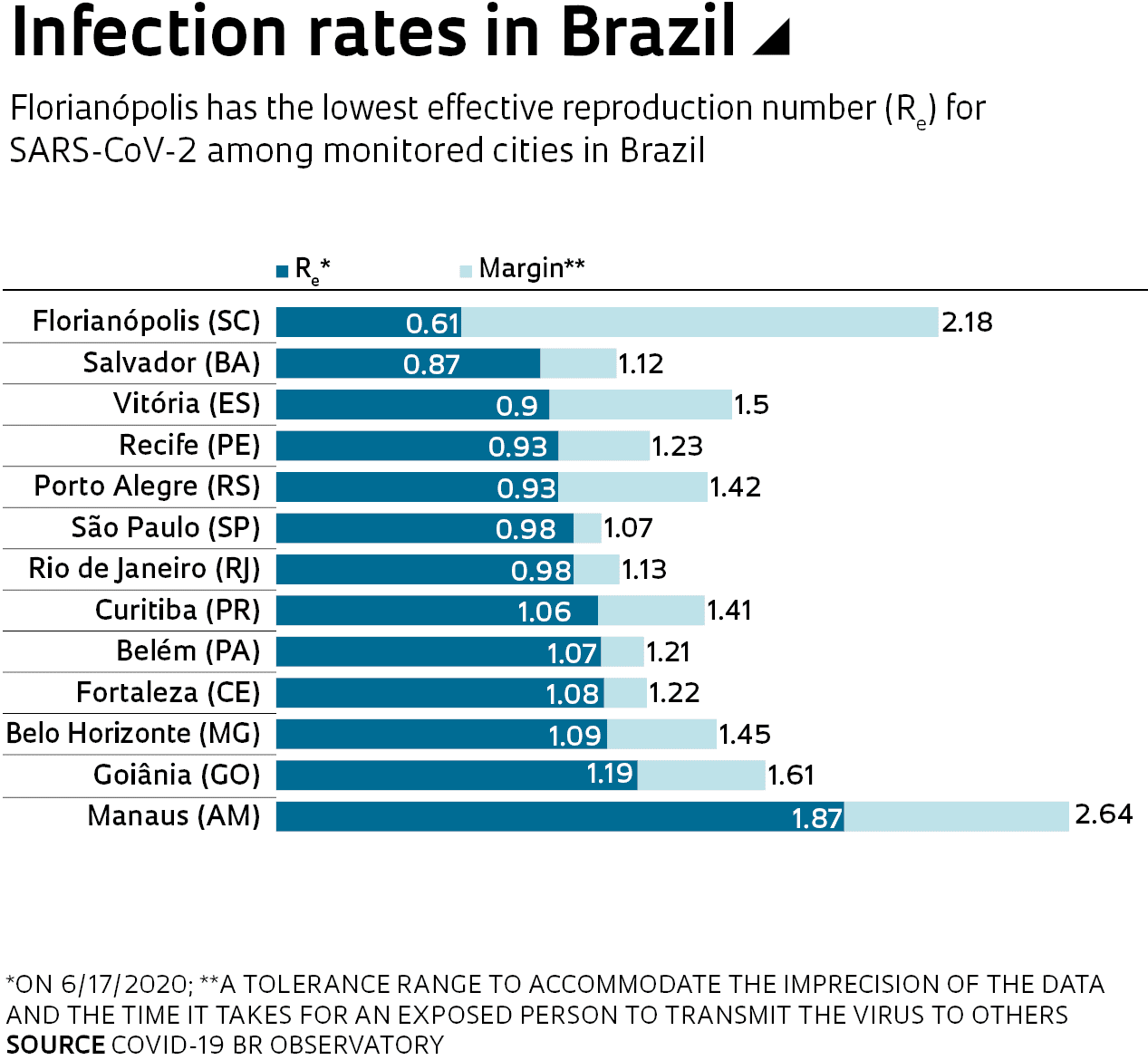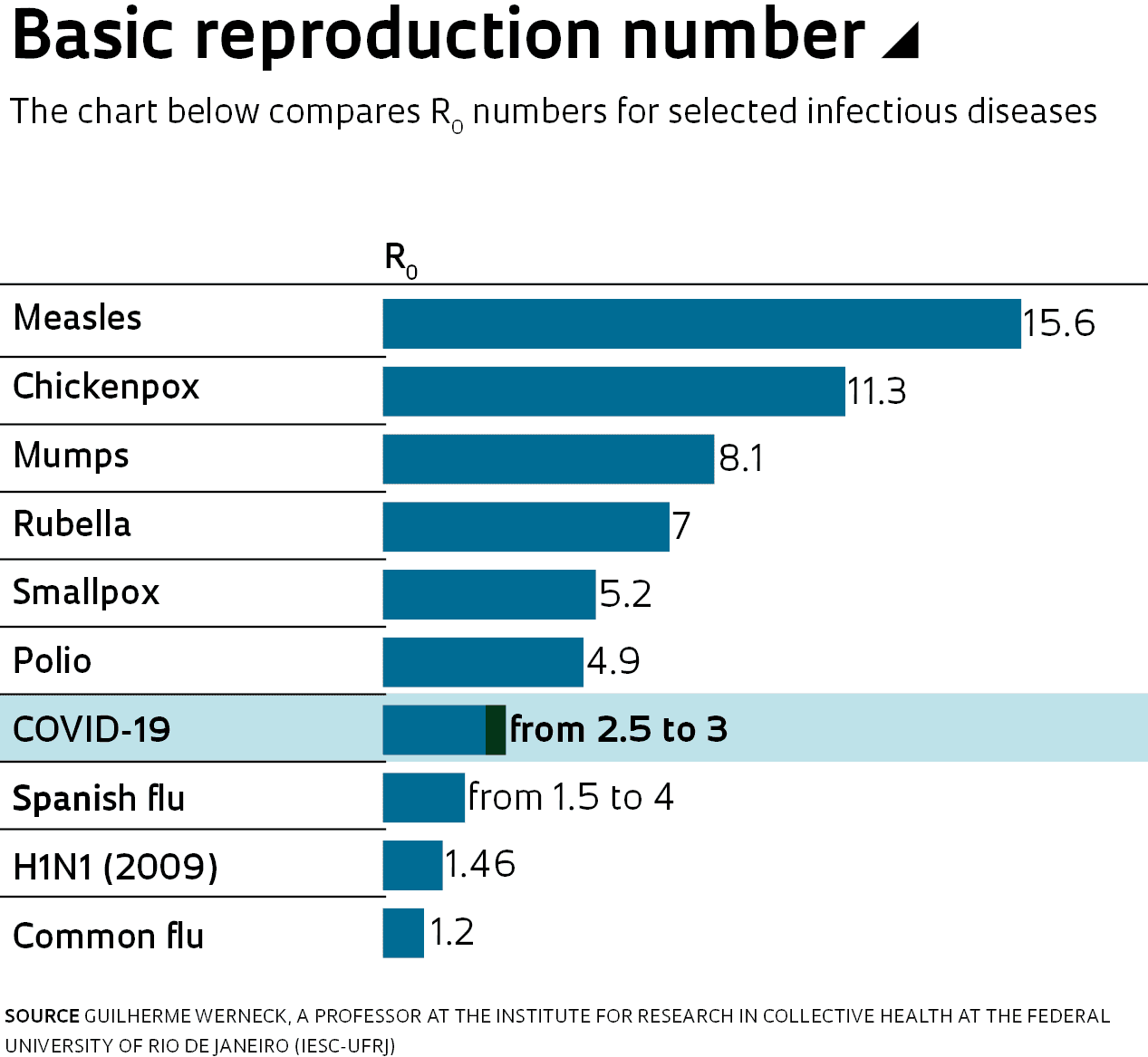Determining the rate of virus spread in a given population over time is essential in effectively managing the response to a pandemic. This is conventionally measured using an indicator known as the effective reproduction number (Re or Rt), which is the average number of people who can be infected by an individual carrying the virus at any specific time.
Governments use the number to estimate future demand for hospital beds, equipment, medicines, and even cemetery space. Knowing the Re value is also important to inform decisions on introducing or lifting lockdowns, explains Hélio Neves, a professor of epidemiology at the School of Medical Sciences at Santa Casa São Paulo (FCM-SC-SP). An Re number of 1 means each infected individual will transmit the disease to one other person. Values higher than 1 would indicate that lockdown measures need to be maintained. Before lockdowns are eased or lifted, the Re number needs to be lower than 1. “Ideally, an Re of 0.7 or 0.8 should be reached before shelter-in-place orders are relaxed,” says Neves. This creates a safety buffer to accommodate the expected spike in cases following relaxation, as was recently the case in São Paulo. The increase in social interaction creates an opportunity for the virus to spread.
– Looking for shortcuts
– Saving time
– Standing alone
– Cristiana Toscano: An unprecedented global effort
– Science takes on the virus
– Calling all scientists
– Each nation’s effort
– Difficult exit
– A difficult return
– Amplified violence
Maria Amélia Veras, an epidemiologist in the Department of Collective Health at FCM-SCSP and a member of the COVID-19 BR Observatory—an independent initiative launched by researchers to provide information and analysis about the pandemic—notes that a very slight change in the Re number can have dramatic effects. In São Paulo, for instance, in a scenario of exponential virus spread, an Re number of 0.95 would lead to 250,000 new cases in a month. If the number were to change slightly to 1.05, the number of infected would increase to 364,000. “That’s a difference of 100,000 in a single month. And that’s why an accurate estimate of the Re number is so important,” says Veras. “The Re number depends on information being accurate and kept up to date if it is to be useful in monitoring the progression of the pandemic.”
The COVID-19 BR Observatory is one of the few groups providing data about the effective reproduction number in Brazil. The database used to calculate the number is less than ideal, but is the only one available. Renato Coutinho, a researcher at the Center for Mathematics, Computation, and Cognition at the Federal University of ABC (CMCC-UFABC), who helps to calculate and publish the observatory’s data, recognizes the problem. Re is estimated from data on the number of Severe Acute Respiratory Syndrome (SARS) cases notified via the Epidemiological Influenza Surveillance Information System (SIVEP-GRIPE), of the Brazilian Ministry of Health.

This dataset is limited, as 80% to 90% of cases will not lead to hospitalization. Another problem is that SIVEP-GRIPE data is not updated regularly enough. Since March, it has been refreshed only once or twice per month. What is more, the reported hospitalizations, discharges, and deaths did not necessarily occur on the date they were reported.
“The average reporting lag is around seven days,” says Coutinho. The observatory adjusts for the lag in its calculations. At the end of June, 25 cities were being monitored by the system.
There are different methods of calculating Re, but in all of them the higher the quality of the underlying data, the more accurate the results. The first step is determining the basic reproduction number, or R0 (R zero), which measures the infectiousness of a pathogen in a population in which no one is immune to the disease. The R0 for SARS-CoV-2—the virus that causes COVID-19—is between 2.5 and 3, meaning an infected individual will contaminate two to three other people on average.
Epidemiologist Guilherme Werneck, vice chairman of the Brazilian Association of Collective Health (ABRASCO) and a professor at the Institute for Research in Collective Health at the Federal University of Rio de Janeiro (IESC-UFRJ), explains that the R0 number is calculated using three primary variables: the average rate of contact between susceptible and infected individuals, the transmission risk at each contact, and the average duration of infectiousness. For COVID-19, transmission begins around two days before an infected individual exhibits symptoms, and continues for seven days.

“The effective reproduction number, Re, is R0 under real-world conditions of virus spread. It is therefore constantly changing, reflecting the level of interaction between people and the infectious agent,” says Werneck. People who are exposed to the infectious agent, in this case SARS-CoV-2, and develop immunity are no longer included in the calculation as potential new cases. The development and widespread application of a vaccine would increase the total number of immunes and would likely shrink the Re number to a figure lower than 1.
In much of Europe and Asia and in several US states, the Re number is calculated based on the present situation. Regular testing provides data on the number of people who have been exposed to the novel coronavirus and have become immune, how many have developed COVID-19, and how many are asymptomatic. This provides a better picture of the actual state of the pandemic.
But with the reporting lags and the absence of mass testing in Brazil, experts have had to resort to a method known as nowcasting, or “predicting the present.” The COVID-19 BR Observatory has used this method to process the data from SIVEP-GRIPE. Another institution tracking the COVID-19 Re number for Brazil is Imperial College London. In its end-of-June report, the Re for Brazil was 1.06, meaning that every 100 people infected by the novel coronavirus were transmitting it to another 106 people.
Virologist Fernando Spilki, chairman of the Brazilian Society of Virology and a researcher at the Laboratory of Molecular Microbiology at Universidade Feevale, in Novo Hamburgo (RS), says that responding to a pandemic like COVID-19 requires an ability to quickly adjust course, especially when the pandemic response needs to be reconciled with keeping the economy running. “Fighting a pandemic is like shooting at a moving target,” says Spilki. “In Brazil, without up-to-date and reliable information, it’s hit or miss.”
Republish

